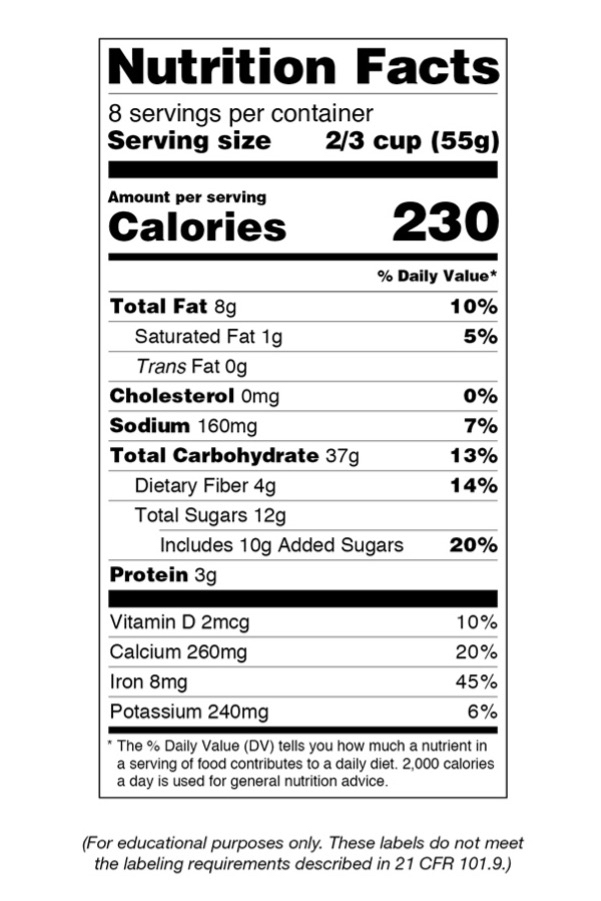Reading a Food Label
encontrar mi
What is a food label?
Most foods have a Nutrition Facts or “food label” on the package. This label shows you what the nutritional facts are of the food. Looking at the label can help you decide if a food is a good choice for you and how much of it to eat. Talk to your care team about what nutrition facts are most important to your dietary needs.
What are the parts of a food label?
Food labels have nutrient sections and have the name of the nutrient on the left. To the right of each nutrient, there are two things shown:
- Grams (g) or Milligrams (mg): a measurement unit that tells you how much of a nutrient is in the food.
- Daily Value Percent (%DV): tells you how much of that food goes toward your daily intake. Daily intake means the food you eat in a day. When looking at %DV, 5% or less means low in a nutrient and 20% or more is high.
These numbers are important to look at if you want to eat more or less of a certain nutrient.
The sections on a food label are:
- Servings per container.
- Serving size.
- Calories.
- Total Fat.
- Cholesterol.
- Sodium.
- Total Carbohydrate.
- Protein.
- Minerals/Vitamins.
What is a serving size?
A serving size on a food label shows you how much is often eaten. It is not a suggestion. This section will also tell you how many servings are in the whole container of food.
What are calories?
A calorie is how much energy you get from a food. The number of calories you should eat in a day is based on your height, weight, sex, age, if you exercise and how much, and your health needs. But most people eat about 2,000 calories daily.
What is total fat?
In the total fat section, you will often see two types of fat:
- Saturated fat is fat that is solid at room temperature and is found in foods like fatty meats (certain cuts of beef and pork, and dark chicken meat) and some dairy foods (whole milk, cheese, and ice cream).
- Trans fat is fat found in foods where liquid oils are turned into solid fat. It is found in fried foods, margarine, shortening, and some frozen foods, among others. Both types of fat can be unhealthy if eaten too much.
What is cholesterol?
Cholesterol is made by the liver, and it is in all cells in the body. Cholesterol levels can be high in cancer cells so your provider may want you to eat a low cholesterol diet. Cholesterol is found in meat, egg yolks, and spreads like butter and cream cheese.
What is sodium?
Sodium is the amount of salt in a food. Sodium can make your blood pressure higher so checking this on a food label is important. If your care team tells you to eat less sodium, the Food and Drug Administration (FDA) suggests eating less than 2,300 mg. daily. Some foods that are high in sodium are bread, pizza, soup, deli meats, popcorn, and pretzels.
What is total carbohydrate?
Total carbohydrates show the total percentage of dietary fiber, sugar, and added sugar in the food. Based on your treatment plan, your provider may want you to have a low-fiber or high-fiber diet. Look at this section to see how much fiber is in the food. Sugar and added sugar are also in this section. Sugar on the food label means the natural sugar in food and drinks. There are natural sugars in milk and fruit. Added sugar means extra sugar that is added as the food is processed. Some cereals, candy, syrups, cookies, and ice cream have added sugars.
What is protein?
Protein helps the body have energy and helps the body to heal. It also helps the body develop and hair, skin, and nails to grow. The FDA suggests that if you are eating 2,000 calories daily, you should have about 50 g. of protein. Some foods that have protein are nuts, meat, soy products, and beans.
What are minerals and vitamins?
The minerals and vitamins at the bottom of a food label such as vitamin D, calcium, iron, and potassium are good nutrients that people often need more of. These are required to be on the label by the FDA.
- Vitamin D: Helps to keep bones and tissues strong by absorbing calcium and phosphorus.
- Calcium: Helps the body develop teeth and keep bones strong.
- Iron: Can help your body make red blood cells, helps with growth and development, and helps to make some hormones.
- Potassium: Helps maintain the fluid balance in our body. It also helps your muscles work and can help you to have a healthy blood pressure.
It can be hard to decide what foods are right for you. A dietitian can help you figure this out. Your provider may want you to have a blood test to see if your body has too much or not enough nutrients. Ask your care team about what you should look for when looking at a food label.
